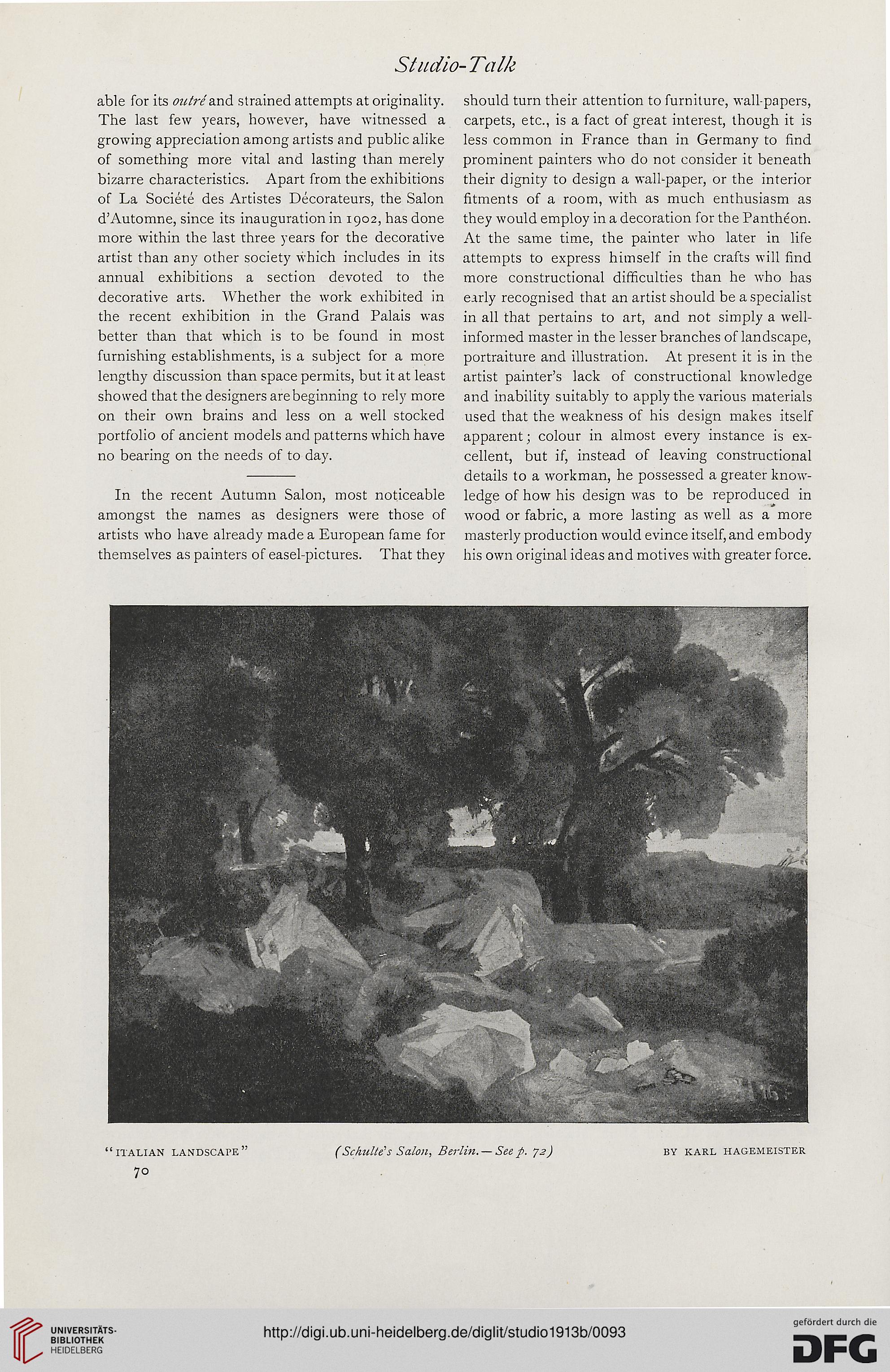Studio-Talk
able for its outre and strained attempts at originality.
The last few years, however, have witnessed a
growing appreciation among artists and public alike
of something more vital and lasting than merely
bizarre characteristics. Apart from the exhibitions
of La Societe des Artistes Decorateurs, the Salon
d'Automne, since its inauguration in 1902, has done
more within the last three years for the decorative
artist than any other society which includes in its
annual exhibitions a section devoted to the
decorative arts. Whether the work exhibited in
the recent exhibition in the Grand Palais was
better than that which is to be found in most
furnishing establishments, is a subject for a more
lengthy discussion than space permits, but it at least
showed that the designers are beginning to rely more
on their own brains and less on a well stocked
portfolio of ancient models and patterns which have
no bearing on the needs of to day.
In the recent Autumn Salon, most noticeable
amongst the names as designers were those of
artists who have already made a European fame for
themselves as painters of easel-pictures. That they
should turn their attention to furniture, wall-papers,
carpets, etc., is a fact of great interest, though it is
less common in France than in Germany to find
prominent painters who do not consider it beneath
their dignity to design a wall-paper, or the interior
fitments of a room, with as much enthusiasm as
they would employ in a decoration for the Pantheon.
At the same time, the painter who later in life
attempts to express himself in the crafts will find
more constructional difficulties than he who has
early recognised that an artist should be a specialist
in all that pertains to art, and not simply a well-
informed master in the lesser branches of landscape,
portraiture and illustration. At present it is in the
artist painter's lack of constructional knowledge
and inability suitably to apply the various materials
used that the weakness of his design makes itself
apparent; colour in almost every instance is ex-
cellent, but if, instead of leaving constructional
details to a workman, he possessed a greater know-
ledge of how his design was to be reproduced in
wood or fabric, a more lasting as well as a more
masterly production would evince itself, and embody
his own original ideas and motives with greater force.
able for its outre and strained attempts at originality.
The last few years, however, have witnessed a
growing appreciation among artists and public alike
of something more vital and lasting than merely
bizarre characteristics. Apart from the exhibitions
of La Societe des Artistes Decorateurs, the Salon
d'Automne, since its inauguration in 1902, has done
more within the last three years for the decorative
artist than any other society which includes in its
annual exhibitions a section devoted to the
decorative arts. Whether the work exhibited in
the recent exhibition in the Grand Palais was
better than that which is to be found in most
furnishing establishments, is a subject for a more
lengthy discussion than space permits, but it at least
showed that the designers are beginning to rely more
on their own brains and less on a well stocked
portfolio of ancient models and patterns which have
no bearing on the needs of to day.
In the recent Autumn Salon, most noticeable
amongst the names as designers were those of
artists who have already made a European fame for
themselves as painters of easel-pictures. That they
should turn their attention to furniture, wall-papers,
carpets, etc., is a fact of great interest, though it is
less common in France than in Germany to find
prominent painters who do not consider it beneath
their dignity to design a wall-paper, or the interior
fitments of a room, with as much enthusiasm as
they would employ in a decoration for the Pantheon.
At the same time, the painter who later in life
attempts to express himself in the crafts will find
more constructional difficulties than he who has
early recognised that an artist should be a specialist
in all that pertains to art, and not simply a well-
informed master in the lesser branches of landscape,
portraiture and illustration. At present it is in the
artist painter's lack of constructional knowledge
and inability suitably to apply the various materials
used that the weakness of his design makes itself
apparent; colour in almost every instance is ex-
cellent, but if, instead of leaving constructional
details to a workman, he possessed a greater know-
ledge of how his design was to be reproduced in
wood or fabric, a more lasting as well as a more
masterly production would evince itself, and embody
his own original ideas and motives with greater force.




